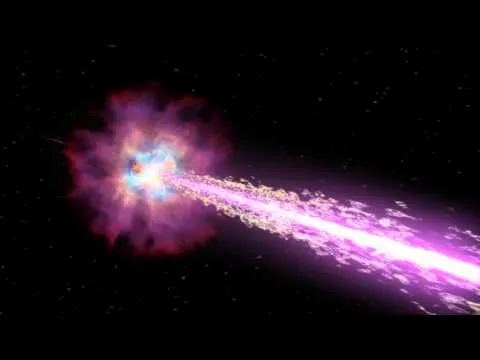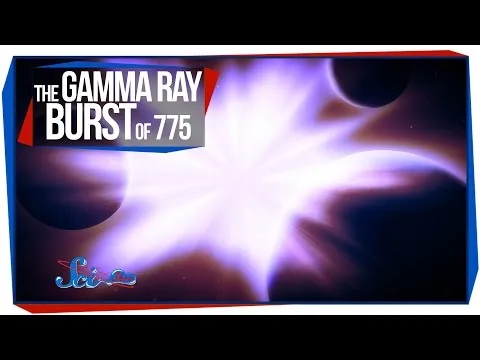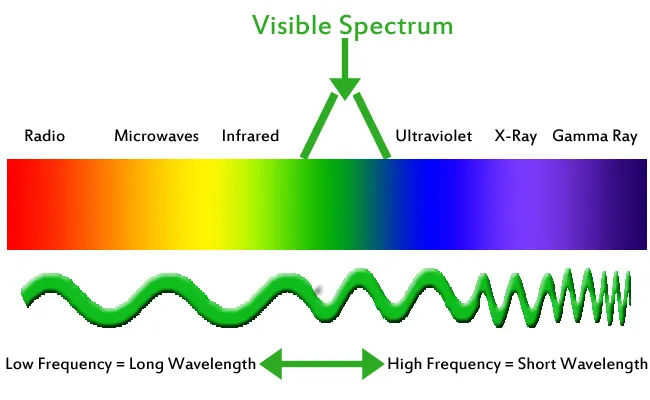There are enormous jets of energy shooting through space, and if one hits us, we're cooked. These jets are like conical lasers, bursting forth from dying stars. They're made of incredibly high-frequency light called Gamma Radiation, and these Gamma Ray Bursts, or GRBs, are the brightest and some of the most destructive events we have ever witnessed.

Artist's depiction of Gamma Ray Burst 080319B in the constellation Boötes. Credit: ESO
What is a Gamma Ray?
Gamma radiation is the most high frequency light we know of. It's a type of electromagnetic radiation, like X-Rays.
Gamma radiation comes from decaying atoms. Sometimes, it's generated naturally here on Earth, like when cosmic rays collide with particles in our atmosphere, or gamma rays that are generated by lightning strikes. It's produced during nuclear fusion from stars, and even during fission from nuclear bomb explosions! We actually discovered GRBs while developing satellites to detect gamma rays coming from nuclear weapons tests.
These waves are incredibly dense, their wavelengths being less than the size of an atom, so when they hit something, they hit it hard. They can ionize matter, meaning they push electrons off of atoms and molecules. Gamma rays aren't special in this, as X-Rays, and high-frequency ultraviolet can also ionize atoms, but gamma rays do it much more effectively.
Sometimes when a star dies, it shoots lasers!
Gamma Ray bursts can contain as much energy as our Sun will produce in its entire life, and does so in just a few seconds! In this short amount of time, a gamma ray burst can shine millions of times brighter than the entire galaxy it's sitting in. These bursts are only produced by a few things, and we would never want to be close to any of them. During hypernovae, long gamma ray bursts are produced, which last for more than 2 seconds. Below is an animation of the same GRB as above, which shows dense jets of radiation shooting in opposite directions as the star collapses and explodes.

Credit: NASA
Gamma rays are also generated in pulsars, which have a constant stream of radiation emanating from them. They are also thought to be produced when neutron stars crash into each other, and when black holes gobble up stars.
Luckily, we've never seen one shoot directly at us.
If we did, whatever side of the Earth got hit would be fried. The GRB could deplete our ozone for years, leaving us vulnerable to dangerous UV radiation from the Sun. A GRB typically gets credit for the Ordovician–Silurian extinction some 450 million years ago that wiped out a huge portion of terrestrial marine life. This is evidenced by fossils of trilobites, which lived closer to the surface, getting a much higher dose of radiation than the creatures living closer to the bottom.
The video below from the Youtube channel SciShow Space describes how a GRB may have hit the Earth just 1200 years ago...

The universe is crazy, and it wants to kill us with lasers. Luckily, scientists believe there won't be much chance of that happening in our lifetime. It's much more likely we'll kill ourselves with lasers long before the universe has a chance to do it. Thank you for taking the time to read this post. If you enjoyed it, and learned something new, Resteem it to your followers so they can be enlightened about space lasers too!
References:
- https://astronomynow.com/2015/09/15/shocks-in-a-distant-gamma-ray-burst/
- https://science.nasa.gov/ems/12_gammarays

Support the Steemit Freelancer's Guild as we build the future of working on the Blockchain!

